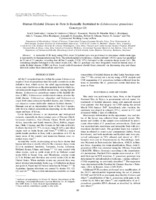Please use this identifier to cite or link to this item:
http://sgc.anlis.gob.ar/handle/123456789/243| DC Field | Value | Language |
|---|---|---|
| dc.contributor.author | Santivañez, Saul J. | - |
| dc.contributor.author | Gutierrez, Ariana M. | - |
| dc.contributor.author | Rosenzvit, Mara C. | - |
| dc.contributor.author | Muzulin, Patricia M | - |
| dc.contributor.author | Rodriguez, Mary L. | - |
| dc.contributor.author | Vasquez, Julio C. | - |
| dc.contributor.author | Rodriguez, Silvia | - |
| dc.contributor.author | Gonzalez, Armando E. | - |
| dc.contributor.author | Gilman, Robert H. | - |
| dc.contributor.author | Garcia, Héctor H. | - |
| dc.date.accessioned | 2012-10-20T22:21:48Z | - |
| dc.date.available | 2012-10-20T22:21:48Z | - |
| dc.date.issued | 2008 | - |
| dc.identifier.issn | 1476-1645 | - |
| dc.identifier.uri | http://sgc.anlis.gob.ar/handle/123456789/243 | - |
| dc.identifier.uri | http://www.ajtmh.org/content/79/1/89.full.pdf+html | - |
| dc.description | A molecular PCR study using DNA from 21 hydatid cysts was performed to determine which strain type is responsible for human infection in Peru. The mitochondrial cytochrome c oxidase subunit 1 (CO1) gene was amplified in 20 out of 21 samples, revealing that all but 1 sample (19/20, 95%) belonged to the common sheep strain (G1). The remaining samples belonged to the camel strain (G6). The G1 genotype was most frequently found in human cases of cystic hydatid disease (CHD) in Peru. Local control measures should focus primarily on decreasing dog and sheep infection rather than intermediate reservoirs. | ES |
| dc.description | Fil: Santivañez, Saul J. Universidad Peruana Cayetano Heredia. Departamento de Microbiología; Perú. | ES |
| dc.description | Fil: Gutierrez, Ariana M. ANLIS Dr.C.G.Malbrán. Instituto Nacional de Enfermedades Infecciosas. Departamento de Parasitología; Argentina. | ES |
| dc.description | Fil: Rosenzvit, Mara C. ANLIS Dr.C.G.Malbrán. Instituto Nacional de Enfermedades Infecciosas. Departamento de Parasitología; Argentina. | ES |
| dc.description | Fil: Muzulin, Patricia M. ANLIS Dr.C.G.Malbrán. Instituto Nacional de Enfermedades Infecciosas. Departamento de Parasitología; Argentina. | ES |
| dc.description | Fil: Rodriguez, Mary L. Instituto Nacional de Ciencias Neurológicas; Perú. | ES |
| dc.description | Fil: Vasquez, Julio C. Hospital Nacional Dos de Mayo. Programa de cirugía torácica y cardiovascular; Perú. | ES |
| dc.description | Fil: Rodriguez, Silvia. Instituto Nacional de Ciencias Neurológicas; Perú. | ES |
| dc.description | Fil: Gonzalez, Armando E. Universidad Nacional Mayor de San Marcos. Facultad de Medicina Veterinaria; Perú. | ES |
| dc.description | Fil: Gilman, Robert H. Johns Hopkins University. Department of International Health; Estados Unidos. | ES |
| dc.description | Fil: Garcia, Héctor H. Universidad Peruana Cayetano Heredia. Departamento de Microbiología; Perú. | - |
| dc.format | application/pdf | ES |
| dc.language.iso | eng | en_US |
| dc.rights | info:eu-repo/semantics/openAccess | en_US |
| dc.source | The American Journal of Tropical Medicine and Hygiene, 2008, 79(1), 89–92. | en_US |
| dc.subject | Equinococosis | en_US |
| dc.subject | Echinococcus granulosus | en_US |
| dc.subject | Zoonosis | en_US |
| dc.subject | Enfermedades de las Ovejas | en_US |
| dc.subject | Humanos | en_US |
| dc.subject | Reacción en Cadena de la Polimerasa | en_US |
| dc.subject | Genotipo | en_US |
| dc.subject | Complejo IV de Transporte de Electrones | en_US |
| dc.subject | ADN Mitocondrial | en_US |
| dc.subject | ADN de Helmintos | en_US |
| dc.subject | Perú | en_US |
| dc.title | Human hydatid disease in Peru is basically restricted to Echinococcus granulosus genotype G1 | en_US |
| dc.type | Artículo | es |
| dc.coverage | PER | en_US |
| anlis.essnrd | 1 | es |
| item.openairetype | Artículo | - |
| item.grantfulltext | open | - |
| item.fulltext | With Fulltext | - |
| item.openairecristype | http://purl.org/coar/resource_type/c_18cf | - |
| item.cerifentitytype | Publications | - |
| item.languageiso639-1 | en | - |
| Appears in Collections: | snrd Publicaciones INEI | |
Files in This Item:
| File | Description | Size | Format | |
|---|---|---|---|---|
| TheAmericanJournalofTropicalMedicineandHygiene,2008,79(1),89–92..pdf | 92.48 kB | Adobe PDF |  View/Open |
Page view(s)
170
checked on Dec 23, 2025
Download(s)
131
checked on Dec 23, 2025
Google ScholarTM
Check
Items in DSpace are protected by copyright, with all rights reserved, unless otherwise indicated.

